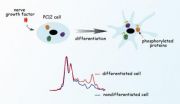(Press-News.org) Even low to moderate levels of exposure to the insecticide chlorpyrifos during pregnancy may lead to long-term, potentially irreversible changes in the brain structure of the child, according to a new brain imaging study by researchers from the Columbia Center for Children's Environmental Health at the Mailman School of Public Health, Duke University Medical Center, Emory University, and the New York State Psychiatric Institute. The changes in brain structure are consistent with cognitive deficits found in children exposed to this chemical.
Results of the study appear online in the April 30 PNAS.
The new study is the first to use MRI to identify the structural evidence for these cognitive deficits in humans, confirming earlier findings in animals. Changes were visible across the surface of the brain, with abnormal enlargement of some areas and thinning in others. The disturbances in brain structure are consistent with the IQ deficits previously reported in the children with high exposure levels of chlorpyrifos, or CPF, suggesting a link between prenatal exposure to CPF and deficits in IQ and working memory at age 7.
The study also reports evidence that CPF may eliminate or reverse the male-female differences that are ordinarily present in the brain. Further study is needed to determine the consequences of these changes before and after puberty, the researchers say.
Notably, the brain abnormalities appeared to occur at exposure levels below the current EPA threshold for toxicity, which is based on exposures high enough to inhibit the action of the key neurological enzyme cholinesterase. The present findings suggest that the mechanism underlying structural changes in the brain may involve other pathways.
According to the lead author, Virginia Rauh, ScD, Professor at the Mailman School of Public Health and Deputy Director of the Columbia Center for Children's Environmental Health, "By measuring a biomarker of CPF exposure during pregnancy, and following the children prospectively from birth into middle childhood, the present study provides evidence that the prenatal period is a vulnerable time for the developing child, and that toxic exposure during this critical period can have far-reaching effects on brain development and behavioral functioning."
"By combining brain imaging and community-based research, we now have much stronger evidence linking exposure to chlorpyrifos with neurodevelopmental problems," adds senior author Bradley S. Peterson, MD, Chief of Child & Adolescent Psychiatry, New York State Psychiatric Institute, and Director of MRI Research in the Department of Psychiatry, Columbia University Medical Center.
In the current study, the researchers used MRI to evaluate the brains of 40 New York City children, ages 5 to 11, whose mothers were enrolled prenatally in a larger cohort study. Researchers compared 20 children with high exposures to CPF with 20 children with lower exposures; all exposures occurred prior to the EPA ban on household use of the chemical in 2001. They found brain anomalies were associated with the higher exposure.
Since the 2001 ban, a drop in residential exposure levels of CPF has been documented by Robin Whyatt, DrPH, a co-author on the present study and Professor of Clinical Environmental Health Sciences and Co-Deputy Director of the Columbia Center for Children's Environmental Health at the Mailman School. However, the chemical continues to be present in the environment through its widespread use in agriculture (food and feed crops), wood treatments, and public spaces such as golf courses, some parks, and highway medians. People near these sources can be exposed by inhaling the chemical, which drifts on the wind. Low-level exposure can also occur by eating fruits and vegetables that have been sprayed. Although the chemical is degraded rapidly by water and sunlight outdoors, it has been detected by the Columbia researchers in many urban residences years after the ban went into effect.
INFORMATION:
The study was supported by the National Institute of Environmental Health Sciences Grants 5P01ES09600, P50ES015905, and 5R01ES08977, as well as pilot funding through ES009089; EPA STAR Grants RD834509, RD832141, and R827027; National Institute of Mental Health Grants MH068318 and K02-74677; and the John and Wendy Neu Family Foundation.
Additional co-authors included Frederica P. Perera and Megan K. Horton, Mailman School; Ravi Bansal, Xuejun Hao, and Jun Liu, Columbia University Medical Center; Dana Boyd Barr, Emory University; and Theodore A. Slotkin, Duke University.
END
On 5 and 6 June this year, millions of people around the world will be able to see Venus pass across the face of the Sun in what will be a once-in-a-lifetime experience.
It will take Venus about six hours to complete its transit, appearing as a small black dot on the Sun's surface, in an event that will not happen again until 2117.
In this month's Physics World, Jay M Pasachoff, an astronomer at Williams College, Massachusetts, explores the science behind Venus's transit and gives an account of its fascinating history.
Transits of Venus occur only on the very rare ...
WASHINGTON, April 30--Atomic clocks based on the oscillations of a cesium atom keep amazingly steady time and also define the precise length of a second. But cesium clocks are no longer the most accurate. That title has been transferred to an optical clock housed at the U.S. National Institute of Standards and Technology (NIST) in Boulder, Colo. that can keep time to within 1 second in 3.7 billion years. Before this newfound precision can redefine the second, or lead to new applications like ultra-precise navigation, the system used to communicate time around the globe ...
Knowing how a living cell works means knowing how the chemistry inside the cell changes as the functions of the cell change. Protein phosphorylation, for example, controls everything from cell proliferation to differentiation to metabolism to signaling, and even programmed cell death (apoptosis), in cells from bacteria to humans. It's a chemical process that has long been intensively studied, not least in hopes of treating or eliminating a wide range of diseases. But until now the close-up view – watching phosphorylation at work on the molecular level as individual cells ...
ROCHESTER, Minn. -- Researchers studying multiple sclerosis(MS) have long been looking for the specific molecules in the body that cause lesions in myelin, the fatty, insulating cells that sheathe the nerves. Nearly a decade ago, a group at Mayo Clinic found a new enzyme, called Kallikrein 6, that is present in abundance in MS lesions and blood samples and is associated with inflammation and demyelination in other neurodegenerative diseases. In a study published this month in Brain Pathology, the same group found that an antibody that neutralizes Kallikrein 6 is capable ...
Scientists predict ocean temperatures will rise in the equatorial Pacific by the end of the century, wreaking havoc on coral reef ecosystems.
But a new study shows that climate change could cause ocean currents to operate in a way that mitigates warming near a handful of islands right on the equator.
Those islands include some of the 33 coral atolls that form the nation of Kiribati. This low-lying country is at risk from sea-level rise caused by global warming.
Surprisingly, these Pacific islands within two degrees north and south of the equator may become isolated ...
Brand India is the name of the organisation that since the late 1990's has been tasked with convincing international corporations and heads of state that they should invest in new, modern India. In return for their investment, they get, among other things, access to cheap, well-educated labour.
"The branding campaigns produce seductive images of 'new' India: In the beginning the ads placed traditional Indian motifs together with images of mobile phones, computers, and motor ways to show the investors how India has developed," says Ravinder Kaur, who is director of Centre ...
The common antibiotic, amoxicillin-clavulanate, may improve small bowel function in children experiencing motility disturbances, according to a study appearing in the June print edition of the Journal of Pediatric Gastroenterology and Nutrition from Nationwide Children's Hospital.
Amoxicillan-clavulanate, also known as Augmentin, is most commonly prescribed to treat or prevent infections caused by bacteria. However, it has also been reported to increase small bowel motility in healthy individuals and has been used to treat bacterial overgrowth in patients with chronic ...
COLUMBUS, Ohio – Just 20 minutes of playing a violent shooting video game made players more accurate when firing a realistic gun at a mannequin – and more likely to aim for and hit the head, a new study found.
Players who used a pistol-shaped controller in a shooting video game with human targets had 99 percent more completed head shots to the mannequin than did participants who played other video games, as well as 33 percent more shots that hit other parts of the body.
In addition, the study found that participants who reported habitual playing of violent shooting ...
COLUMBUS, Ohio - People aren't very good at media multitasking - like reading a book while watching TV - but do it anyway because it makes them feel good, a new study suggests.
The findings provide clues as to why multitasking is so popular, even though many studies show it is not productive.
Researchers had college students record all of their media use and other activities for 28 days, including why they used various media sources and what they got out of it.
The findings showed that multitasking often gave the students an emotional boost, even when it hurt their ...
Boulder, Colo., USA – Studies in this Geology posting cover direct dating of brittle fault activity along the Dead Sea fault zone in Northern Israel; onset of the last deglaciation of valley glaciers in southern Patagonia; cutting-edge techniques, including NanoSIMS ion mapping, to identify the microbial metabolism involved in ooid cortex formation; slope failure at Scripps Canyon, California; and the continuing and relatively quick uplift of the U.S. Sierra Nevada, which gains 1-2 mm per year in elevation.
Highlights are provided below. Geology articles published ahead ...


